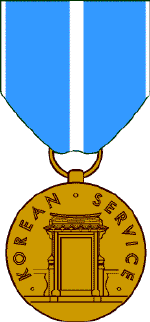
The Korean War was significant in the fact that it was the first war in which the newly independent United States Air Force was involved.
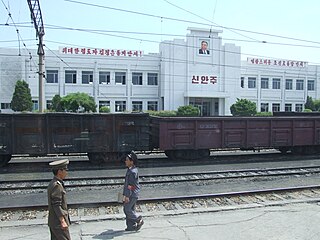
Sinanju is a region (신안주) in Anju city, South Pyongan Province, North Korea. The name literally means "Comfortable New Village." When Anju County was raised to the status of a city in August 1987, Sinanju Workers' District was divided into Sinwon-dong, Wonhung-dong, Yokchon-dong.

The 19th Airlift Wing is a United States Air Force unit assigned to the Air Mobility Command's Eighteenth Air Force. It is stationed at Little Rock Air Force Base, Arkansas. The wing is also the host unit at Little Rock.

The Korean People's Army Air Force is the unified military aviation force of North Korea. It is the second largest branch of the Korean People's Army comprising an estimated 110,000 members. As of 2024, it is estimated to possess some 570 combat aircraft, 200 helicopters, and a few transporters, mostly of decades-old Soviet and Chinese origin. Its primary task is to defend North Korean airspace. In April 2022, the Korean People's Army Air and Anti-Air Force name was changed to Korean People's Army Air Force.

The attack on the Sui-ho Dam was the collective name for a series of mass air attacks during the Korean War on thirteen hydroelectric generating facilities by United Nations Command air forces as part of the North Korean bombing campaign on June 23–24 and June 26–27, 1952. Primarily targeting the hydroelectric complex associated with the Sui-ho Dam in North Korea, the attacks were intended to apply political pressure at the stalled truce negotiations at Panmunjeom.
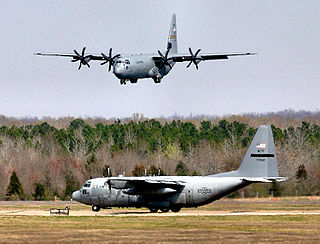
The 19th Operations Group is the operational flying component of the United States Air Force 19th Airlift Wing, stationed at Little Rock Air Force Base, Arkansas.

The United States Air Force in South Korea is composed of units assigned to Pacific Air Forces Seventh Air Force. The mission of the personnel, equipment and aircraft is to deter, protect and defend the Republic of Korea from attack from the Democratic People's Republic of Korea (DPRK) or more commonly known as North Korea.

The 344th Air Refueling Squadron is a unit of the US Air Force, part of the 22d Air Refueling Wing of Air Mobility Command at McConnell Air Force Base, Kansas. It operates the Boeing KC-46 Pegasus aircraft conducting aerial refueling missions.
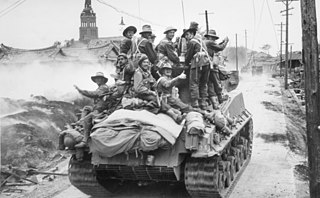
The Battle of Sariwon took place on 17 October 1950 during the United Nations (UN) counter-offensive against the North Korean forces which had invaded South Korea. With many Korean People's Army (KPA) units falling back under pressure from UN forces the 27th British Commonwealth Brigade under Brigadier Basil Coad—–comprising the 1st Battalion, the Argyll and Sutherland Highland Regiment, the 1st Battalion, the Middlesex Regiment and 3rd Battalion, the Royal Australian Regiment (3RAR) captured the town of Sariwon during a confused and largely one-sided action. Elements of the 7th US Cavalry Regiment were also involved. KPA casualties included 215 killed and more than 3,700 captured, whilst British-Commonwealth losses were 1 killed and 3 wounded.
This is the order of battle for United Nations and North Korean forces during the Battle of Pusan Perimeter in August and September 1950 during the Korean War. The engagement brought each side to muster substantial ground, air and sea resources to fight across southeastern Korea.
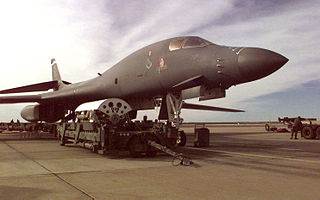
The 345th Bomb Squadron is a United States Air Force Reserve squadron, assigned to the 489th Bomb Group. It is stationed at Dyess Air Force Base, Texas, where it is an associate unit of the 7th Bomb Wing.
Mirim Airport, also known as Pyongyang East Airfield or K-24 Air Base, is an airport in Mirim-dong, Sadong-guyok, Pyongyang-si, North Korea.
The Air Battle of South Korea was an air campaign early in the Korean War occurring roughly from 25 June to 20 July 1950 over South Korea between the air forces of North Korea and the United Nations, including the countries of South Korea, the United States and the United Kingdom. The month-long fight for air supremacy over the country included several small engagements over airfields in Seoul and Taejon and ultimately ended in victory for the UN air force, which was able to destroy the small North Korean People's Air Force.
Pyongyang Air Base also known as Heijo Airfield or Pyongyang (K-23) Air Base was a former Imperial Japanese Army Air Service, Korean People's Air Force (KPAF) and United States Air Force (USAF) air base adjacent to the Taedong River in Pyongyang, North Korea. It was redeveloped after the Korean War as a Government and residential area.

Yonpo Airfield, also known as Yonpo Air Base or K-27 Air Base, is an airport near Hamhung, South Hamgyong Province, North Korea.
Operation Strangle was a sustained interdiction attack on North Korea's supplies and communications by the United Nations forces during the Korean War. Beginning in August 1951, the campaign's 87,552 interdiction sorties were credited with destroying 276 locomotives, 3,820 railroad cars, 19,000 rail cuts, and 34,211 other vehicles. The North Koreans countered the campaign by moving anti-aircraft (AA) guns and crews towards the front line and placing them in higher concentrations around important targets, causing heavy casualties in the UN forces. Despite high losses, Operation Strangle destroyed 900 AA gun positions and damaged 443.

Following the North Korean invasion of South Korea in June 1950, air forces of the United Nations Command began an extensive bombing campaign against North Korea that lasted until the end of the Korean War in July 1953. It was the first major bombing campaign for the United States Air Force (USAF) since its inception in 1947 from the United States Army Air Forces. During the campaign, conventional weapons such as explosives, incendiary bombs, and napalm destroyed nearly all of the country's cities and towns, including an estimated 85% of its buildings.
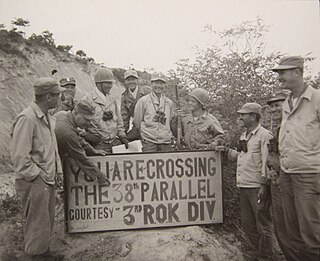
The UN offensive into North Korea was a large-scale offensive in late 1950 by United Nations (UN) forces against North Korean forces during the Korean War.
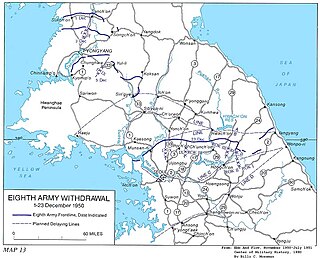
The UN Forces retreat from North Korea was the withdrawal of United Nations (UN) forces from North Korea that took place from 2–25 December 1950.














